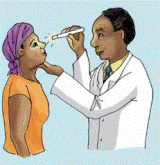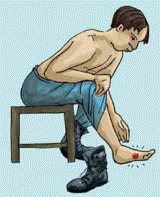This article focuses on ‘Type 2 Diabetes’ which in most cases develops in adults due to a combination of genetic and lifestyle factors. On the centre spread (page 9), you can read about the symptoms and risk fac-tors associated with diabetes.
An emerging global epidemic
In 2010, the World Diabetes Foundation estimated that 285 million people were living with diabetes. That means that six out of every 100 people in the world are affected by this disease. The number is expected to grow to 438 million by 2030.
A leading cause of disability
Diabetes could become one of the world’s leading causes of physical disability over the next decades. Diabetes leads to many serious health conditions. People suffering from diabetes can often experience loss of sensation in their feet. Even the smallest injury can lead to infection which, if not treated promptly, may lead to serious complications. Diabetes now causes a high proportion of all leg amputations.
If left undiagnosed, diabetes can lead to permanent damage to the eyes and, in some cases, to blindness. Your eye has a lens and an opening at the front which adjust to bring objects into focus on the retina at the back of the eye. The retina is made up of delicate tissue that is sensitive to light rather like the film in a camera. The centre of the retina is a small area called the macula. It is vital because it enables you to see fine detail. The medical name for the damage caused to the retina by diabetes is diabetic retinopathy.
Diagnosis
It is very important that people find out that they have diabetes as early as possible to avoid the serious damage which the disease can cause. If you notice symptoms of diabetes (see page 9) in yourself or in a friend or relative, you should seek medical help. If you are diagnosed with the disease, doctors can give you advice on how to manage the disease and continue to live a healthy and active life.
For more information on diabetes visit the International Diabetes Federation website: www.idf.org
PRACTICAL GUIDES
Eyes











